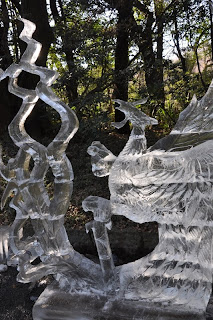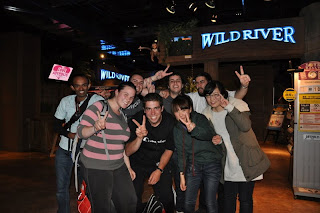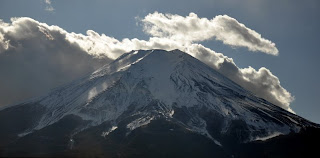Initially this was going to be just a simple reflection, but it has now grown into a fully fledged guide to Tokyo that includes all our major cultural experiences.
I didn't plan on creating such an elaborate guide, but I enjoyed looking back over the trip and writing about it and thought I may as well publish this to the world. You never know, maybe it might help someone one day.
I would recommend reading this if you plan on going to Tokyo, for two reasons.
The first is just to be prepared for the Japanese customs and the second is to get you even more excited about going to this amazing city!
Trains
The train system in Tokyo is so much more advanced than ours in Melbourne and is one of the first things you notice upon arrival.
In Tokyo, the train lines are all owned and operated by different companies, including "Tokyo Metro", "JR - Japan Rail" and a number of private lines. Just the map of the Tokyo Metro lines by them selves is enough to give any Aussie a bit if a surprise. It is a mesh of lines going everywhere which is what makes it work so well. You would think that this mass of train lines would mean there would be delays and confusion, but you would be hard pressed to find a train more than one minute late.
Everything is made to be efficient. In peak times, they even have staff members to push the people on so the doors can close on time. There are plenty of doors and 10 times the amount of hand rails inside the carriages. There are also marking on the floor at the platform so you know where to stand to line up with the train doors!
The ticketing system is great. There is a list of stations at every train station that outline the cost of getting anywhere from where you are. Generally it will be one of about 4 prices. Once you know this, just go to the touch screen ticket machine, press English and then the price of the ticket you need, give it some cash and it'll give you your ticket.
Once you have this, put your ticket through the gate and collect it as you walk through, then at your destination station, put it through again and it will keep it.
If you happen to get the wrong ticket, at every station there are "Fare correction machines". Where if you didn't pay enough (and the gate doesn't let you through) you pay the machine the left over in order to get out, and likewise if you paid too much, the machine will give you a refund - too easy!
Navigating the spaghetti map of train lines is actually pretty easy by just looking at it, but if not, at every gate there is a staff member to help out with ticket problems and directions (these stations are normally massive!). Also, if you get lost trying to exit the station, just look for the little green exit signs on the floor, walls and ceiling - there everywhere.
It is pretty common for a station to have alot of levels under ground, as alot of stations will service around 4 lines! This means alot of stairs! The stations are generally part of shopping complexes owned by the train companies too, which just adds to the size of these places.
Anther good thing is that instead of buying a ticket for every trip, they have a number of prepaid travel cards. The one we used was "Pasmo". This card can be loaded with cash at a ticket machine and then all you do is touch on and touch off, just like the proposed MyKi system for melbourne will most likely be.
The card costs 500 Yen (where most of this can be refunded when you're finished with it) and you can even register your name on the card from the machine and it will print it on the front for you - which makes for a pretty cool souvenir.
These cards can not only be used at train stations, but also at vending machines (for just about anything) and places like FamilyMart and shopping centers!
Another small note is that the gates will generally stay open and only close if someone tries to walk through without scanning their card or ticket first. Which is so clever compared to Melbourne - if anyone has seen peak hour at Melbourne Central!
Heat Packs ("Hokkairo")
We discovered these thanks to Sarma's extremely low threshold for cold and some friendly Japanese locals at new years eve.
These come in a variety of shapes and sizes, including some for the soles of your feet, little bean-bag like packs and sticky packs for the inside of your clothes.
There is no need to do anything to these packs, all they need is a bit of warmth from either your own body heat or some friction and eventually they get so hot that sometimes they are too hot to hold! For people like us, not used to the cold, these were used heavily. Everyday we would stop at the local FamilyMart to get some more, and they were relatively cheap at around $1 each when you buy a 10 pack.
Crazy Fashion
The heat packs brings me to my next point - fashion!
We went to Tokyo over new years eve, which is their Winter. On new years eve, the temperature was about 2° and while we were rugged up in alot of clothes and heatpacks and still shivering, the local Japanese girls were still running around in miniskirts!
Naturally, I'm wasn't complaining, they all seem to dress either really well (in terms of fashion and looking good) or absolutely bizarre (see "mamba" from Shibuya, or "cosplay" from Harajuku). But all trip I just could not get over the fact that we were all freezing and they were baring leg!
I hope too many people didn't see my jaw dropped reaction to these girls, they might have got the wrong impression, lol.
Bidet Toilets
One of the other things that westerners first notice is the crazy control panel on the side of the toilet. This is a pretty new concept for most Aussies, but if your not too freaked out by it, it is actually really good.
Instead of wiping your backside, when your finished, you set your water pressure and press the "wash" button. A warm jet of water cleans you and all you have to do is dry yourself with some toilet paper. It sounds weird to us, but once you get used to it, it is much cleaner, faster and softer than using toilet paper. There is also a "bidet" button, but guys, don't push this button as its intended for females ;)
The more advanced bidet toilets will dry you and have seat warmers built in.
Some even play music or water sounds in case you want to mask your own noises, lol.
Vending Machines
As mentioned earlier, you can get just about anything out of a vending machine. Theres the usual cold drinks (including a cool little aluminum coke bottle), but vending machine are also used for hot drinks (hot coffee in a can), noodles, ordering food, buying admission tickets into tourist attractions and parks, magazines, comics, porn, ice-cream, train tickets, cigarettes and just about anything you can think of. I have even read that you can buy used school girl panties in some of the more seedy parts of Tokyo.
Restaurants
One thing that we didn't expect is how hard it was to find a good restaurant. We expected the language barrier while ordering, but with the pictures in the menu and the 3D wax models out the front, that was not too bad.
Unlike here, the streets aren't always filled with options to choose from for dinner, you have to search a bit. Alot of the properties in Tokyo take up a fairly small ground area, but then go 10 levels high, with a different business on each floor, so the signs out the front are the only key to if there is a restaurant inside.
We went to a few places that looked well priced, but when the meals came out, they were very small and reminiscent of a Tapas experience - not great.
Train stations are a good place to look for food places as they are normally big complexes with lots of different shops, but in our experience, you dont get alot of choice unless you find a food court or a really busy area.
Also, it is not uncommon to have to take your shoes off at a fancy restaurant, we were given a locker for our belongings at one particular Japanese place. Alot of places also have buzzers under the table or on the wall, where when you press it, your waiter will run over with an electronic notepad to take your order.
Smoking
Speaking of restaurants, it is also important to note that the Japanese smoking laws are somewhat opposite to here in Australia. You are not allowed to smoke in the street, unless in a designated "smoking area" but you are allowed to smoke indoors and in restaurants! Alot of restaurants don't have a non-smoking section, or if they do, are not always really separated from the smoking section (which kind of defeats the purpose). If you are a smoker, you might even like this, but for us non-smokers, it is really annoying!
Also, being a non-smoker, I wouldn't know too much about this, but I believe the smoking vending machine may require Japanese ID. You may need to do a little research with that one, but I'm sure it wont be too hard to get smokes over there.
Local Japanese people
The Japanese people are so friendly! We had quite a few times where some random people would notice we are foreigners and just come up and starting talking (broken) English to us. These people welcomed us to Japan and wished us good luck. I think alot of these people liked an opportunity to practice their English.
While we were waiting to see the Emperor of Japan amongst a crowd of thousands, a Japanese Nikon enthusiast next to me noticed I had the same camera as him. We ended up speaking for about 45 minutes, but the funny part is, I was speaking English (that he couldn't understand) and he was speaking Japanese (that I couldn't understand). But with alot of guessing, smiling and pointing, we managed to convey the points we needed to hold a conversation.
The moral of the story is that even of they don't understand English, they all try to help out as much as possible, even if it is as simple as pointing to a meal and saying "pork", they will do their best to help out.
Even in shops and restaurants, if the person serving you cannot speak English and is struggling to help you, they will try to get the staff member that has the best English skills to take over - even if they aren't always that much better.
Another example of the friendly locals is during our stay in Ginza. We were trying to find a decent, cheap restaurant (which was pretty hard in Ginza) and ended up asking a local Japanese lady and her mum for directions. This lovely lady ended up speaking very good English and regardless of what she had to do, walked our group through Ginza to a place that could be suitable, even came in with us and helped us order. We were so impressed with this kind gesture, we ended up exchanging details and meeting again so we could buy her dinner in return.
Dogs
There is actually a surpring amount of dogs in Japan, but unlike places such as Vietnam, we didn't see any wild dogs. Infact, it was very opposite, these dogs are spoilt! Everybody seemed to walk their dogs all the time and we even saw alot of dogs in clothes (yes, dog jeans, jumpers, shoes, etc.). There are even department stores for dogs and some cafes are dog friendly. This isn't one of the things that stood out strongly, but day-after-day you start to realize this more and more.
Convenience Stores
One thing we didn't see too much of were full grocery stores like Coles/Safeway/etc. Instead there is a great store called "Don Quijote" which is a multilevel store that sells just about everything!
The few that we visited had everything including food, clothes, sexy costumes, bikes, electronics, home goods and much more.
However, these are normally situated in the more busy parts of the city, which we were lucky to be fairly close to, but otherwise, on almost every corner you will find a "Family Mart", "AM PM" or "7-11" (7-11 actually has a slightly different name over there, but I cant remember what it was).
These places stock bread, fruit and veges, alcohol, batteries, cd's, hot food, magazines, heatpacks, smokes and alot more. They normally even have vending machines out the front and you can generally use your Pasmo at the register.
Everything is "cutified"
Another minor thing we noticed, which was kinda fun, is that everything is "cutified"! Everything from the street signs, warning signs, advertisements and construction signs to the anime, the way the girls speak and act, and the costumes warn in the streets are all made to look "cute".
I doubt you would ever see Connex (or now "Metro") use a furry cartoon critter in a sign to warn people to watch their fingers on the trains, but in Tokyo you cant avoid it, its everywhere!
Mobile Phones
I am so used to having a mobile phone that going to Japan was one of the first times in a long time I had to go without.
If I really couldn't live without it, I could have enabled roaming with my provider and taken my phone and SIM card with me, but at least for my provider, this is a really expensive exercise, and on a student wage, not really an option.
I did bring my phone for other reasons, such as the local time and Aussie time, currency converter, alarm clock, calendar, phonebook, wifi, etc. but left it in offline mode the whole time.
In other countries, like Thailand and Vietnam, normally I would bring my phone and buy a prepaid SIM card to use during my trip, even if just for local calls to my friends doing the same thing.
Unfortunately (at the time of writing), in Japan, the process for a foreigner to get a SIM card is far to complicated (and apparently expensive) to warrant even trying.
So our group attempted to do it old school! When we were going to split up, we set a meeting place and time somewhere familiar, and in the worst case scenario, we all knew how to get back to our hotel, or at least had the name and address of our hotel to get directions back.
Thankfully, we did pretty good and didn't need to revert to meeting at the hotel.
There was another option and that was to rent a mobile. There were rental services that were foreigner-friendly, but quite honestly, we didn't really need it.
... Weird for me saying that, but at the same time, there were a few instances where it would have been helpful.





















































